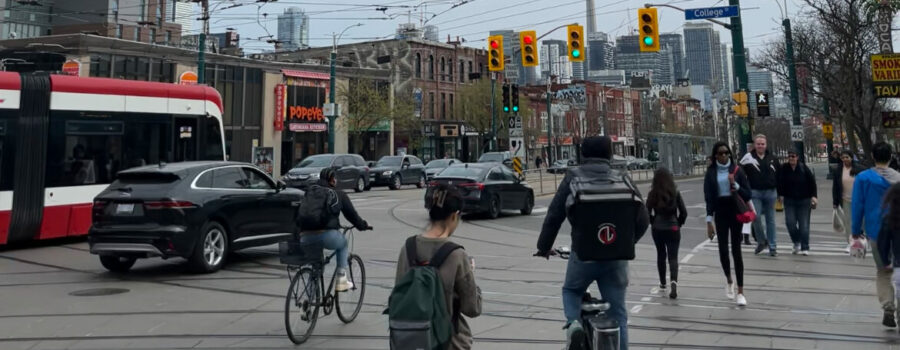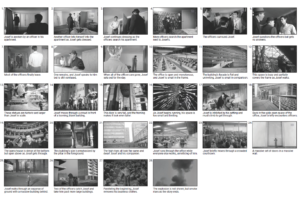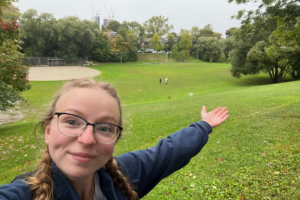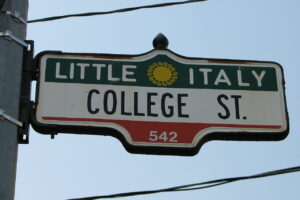Whenever I felt sick as a child, my mother would rest her hand against my forehead to check if I had a fever. She did this because body temperature is one of a few essential measurements of health referred to as vital signs. The Toronto Foundation, a charity that works towards equity within the city, titles its annual report Toronto’s Vital Signs because it measures the health of the city by examining key issues (Toronto Foundation, 2021). Chapter nine of the 2021 report discusses the vital sign of transportation, which is important because Toronto is one of the most populous cities in North America; there are a lot of people here, and they all have places to go and need ways to get there. Transit decisions affect how millions of Torontonians spend their money and time. In this paper, I discuss the pandemic’s effects on public transit ridership and active transportation as presented in the report, followed by various perspectives on this issue. Opinions differ on the best route forward, but one with careful and considerate investment into both public and active transportation will shape a better Toronto where everyone has reliable access to the transit that they need.
The majority of this chapter is devoted to examining how the pandemic led to decreased public transit ridership and increased rates of walking and cycling, and how various people groups have been affected by this. It also outlines how these issues could progress in the future based on a collection of reports and initiatives. Every mode of transit slowed during the lockdowns but when the government loosened restrictions, vehicle congestion returned to pre-pandemic levels much faster than TTC ridership did (TomTom, 2021). This significantly affected TTC revenues beyond what government aid covered, leading to concern about a transit death spiral: increased fares that lead to decreased use which lead to further price increases which eventually decrease any interest in ridership (TTCriders, 2021).
This is a problem because these costs would be paid by transit users, many of which are in low-income and marginalized groups and are already suffering the brunt of the pandemic’s impact (Chief Executive Officer, 2021). Since they cannot afford a car, or even a parking space for that matter, public transit is their best option. Despite this, the TTC has increased its fares at double the rate of inflation over the past twenty years, has one of the lowest monthly pass discounts and the lowest operating budget of any North American city transit system (MacLeod et al., 2018). With this information in mind, an advocacy group called TTCriders (2021) is calling for increased investment in the TTC and lowering fares instead of increasing them.
Both the TTC and the City of Toronto conducted reviews of the fare policies and have looked into various measures they can take toward a more equitable system, such as the Fair Pass initiative, which helps low-income residents afford transit (Executive Director Social Development, 2020). The discount, while still small in comparison to similar initiatives in other cities, made an impact in many people’s lives; it gave them the agency to get out and invest in their communities, which led to a high financial return and proved the benefit of expanding the initiative (TTCriders, 2021). Affordability is a major factor in the issue of public transit: it affects the user’s decision to take it and it affects the government’s decision to invest in it. Buses and bike lanes cost less than highway expansions, and spending money this way can directly benefit Toronto’s marginalized groups.
This section of the chapter concludes by highlighting how the pandemic caused many Torontonians to take up cycling instead of using public transit, seeing it as the cheaper and safer option (Roberts, 2021). It is also the greener option, but this is a low priority for most. The city has also invested in active transit infrastructure, with additional bike lanes and Bike Share stations being built throughout Toronto. However, these investments reflect a mentality around cycling that focuses on recreation and ignores practicality. Low-income groups outside of the downtown core have different needs that have not been met. There is evidence that the expansions in the downtown core have increased cyclists’ access to various aspects of the city (Lin et al., 2021), but this has yet to reach other neighbourhoods.
When discussing the issue of Toronto’s public transit system, it is important to recognize how young it is, especially when comparing it to other cities. For example, Toronto’s Line 1 was built after the Second World War, making it several decades younger than New York’s extensive subway network (Filion et al., 2015). CodeRedTO, a non-partisan transit advocacy group, considers this when selecting cities to examine. They focus on other North American cities with similar timelines and development so that the comparison is constructive toward reasonable change. Larger and older systems are still worth studying as they provide goals to strive towards, but it is inappropriate to directly compare Toronto to them (MacLeod et al., 2018). This perspective should be maintained when discussing Toronto’s transportation issue and considering various solutions.
The pandemic majorly affected people’s transportation decisions, and urbanists are examining these decisions in order to better understand its impacts. They found that nearly all citizens were concerned about infection and wanted to be socially distant as much as possible; those who could afford to used private vehicles, but there were large numbers of Torontonians who could not and continued to use public transit for necessities such as groceries despite the risks (Palm et al., 2021). One of the ways that the TTC addressed these risks was with increased sanitation practices. University of Nebraska urbanists Bradley Bereitschaft and Daniel Scheller (2020) recommend that these practices become permanent, even when pandemic recovery efforts are over. Public transit has a reputation for being dirty and spreading disease due to the sheer amount of people that use it every day, so these practices could limit the spread of illness and benefit transit users, especially those in low-income and marginalized groups.
These groups are a key element in discussions on transportation, with various perspectives searching for methods to improve transit equity. Development during the pandemic proved that new infrastructure is most successful when linked with existing infrastructure (Lin et al., 2021). However, planners should be careful not to let this be an excuse to limit development to where there is more existing infrastructure. This would disproportionately benefit the downtown core and leave out exterior neighbourhoods, which have a greater need. Solutions should be specific in design so that they are achievable but general enough to address the diversity of users (Acuto et al., 2020). If a solution can be applied across the entirety of Toronto’s transit system then it can benefit a wide range of transit users. Urbanist Joe Grengs’ (2018) perspective on the issue is that transit planning should be centred around accessibility and actively addressing disadvantages instead of just avoiding making them worse. This change in mindset would be reflected in policies and not only encourage movement but also interaction and prioritize agency for members of marginalized groups.
Discussions about transit equity should also include active transportation, especially since it has become increasingly common since the pandemic. A study was completed in Montréal that looked at various modes of transit and considered the gaps between the space allotted to each and how much was needed according to demand. The study found that bus riders and cyclists have the largest gap, meaning they have the most needs that are not being met (Lefebvre-Ropars et al., 2021). Toronto faces similar issues because most of the streetscape has been allocated for vehicles, followed by pedestrians: public and active transit are an afterthought. This negatively affects every Torontonian, not just the ones on buses and bikes, but they are the ones affected the most.
One of the biggest issues with Toronto’s streetscapes, especially the current cycling infrastructure, is safety. Urbanists John Pucher and Ralph Buehler (2016) studied cycling infrastructure across North America and Europe and found that both traffic calming zones and cycle tracks—wide bike lanes with physical barriers separating them from the road—lowered crash rates and increased ridership. I can personally attest to this, as I have lived in Toronto for years but have never ridden a bike because I do not feel safe with only a painted line separating me from the cars speeding past. If the streets had better infrastructure, other Torontonians with similar concerns might consider cycling. Safer streets would also aid in encouraging cycling among children. Safe and intentionally designed routes to schools can encourage active transit and start building healthy habits from a young age (Stewart et al., 2014). When streetscapes shift emphasis away from private vehicles, citizens’ experiences on that street are more equitable and improved.
Toronto’s next steps to address its transportation issues must be feasible and work with what is already there. While there are numerous examples of cities that boast highly successful public and active transportation infrastructure such as New York, Tokyo and Paris, each has its own unique aspects that have resulted in its current state. These cities are thus unrealistic to directly compare Toronto to. The first steps are continued investment into programs such as Fair Pass and Bike Share alongside funding to aid recovery from the pandemic without putting the burden on users. The most immediate priority is addressing the negative impacts and preventing any further losses. Many cities are dealing with this issue, so learning from other examples and collaborating to find solutions would likely be beneficial.
Further down the line, Toronto would benefit from diversified and dynamic streetscapes, which create better experiences both on the streets and in the surrounding areas. Ultimately, everyone is trying to find the best way to get to where they need to be and sorting them all into rigid categories is short-sighted: no one is solely a cyclist or a pedestrian or a driver. My roommate uses the Bike Share program to go to school but rides the streetcar back home because that is what works best for her. Investments that maintain current transit ridership are beneficial, but investments that encourage vehicle owners to switch to public or active transit are even more so. The future of transportation in Toronto considers the relationships between different modes and seeks opportunities to ease transitions from one to another. If we strive for these goals then when Toronto Foundation checks this vital sign in the future, the results will show a healthier and more equitable city.





